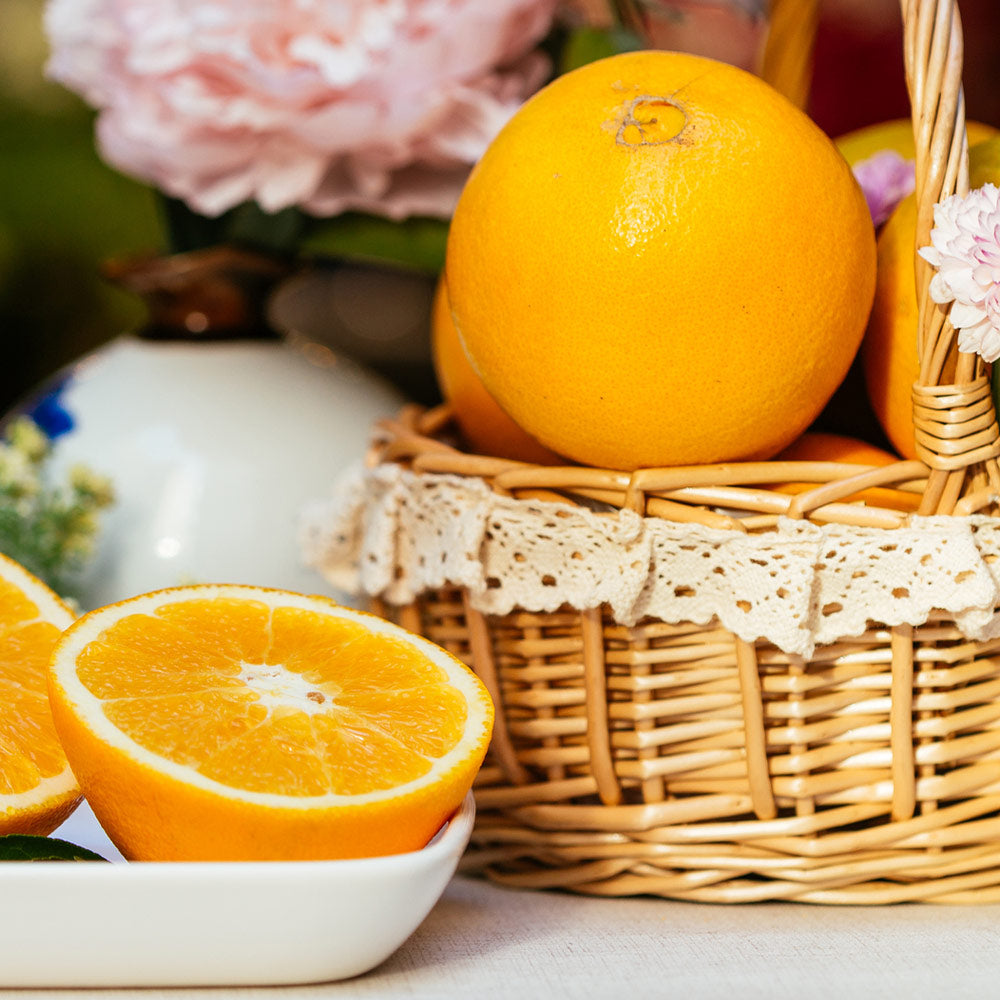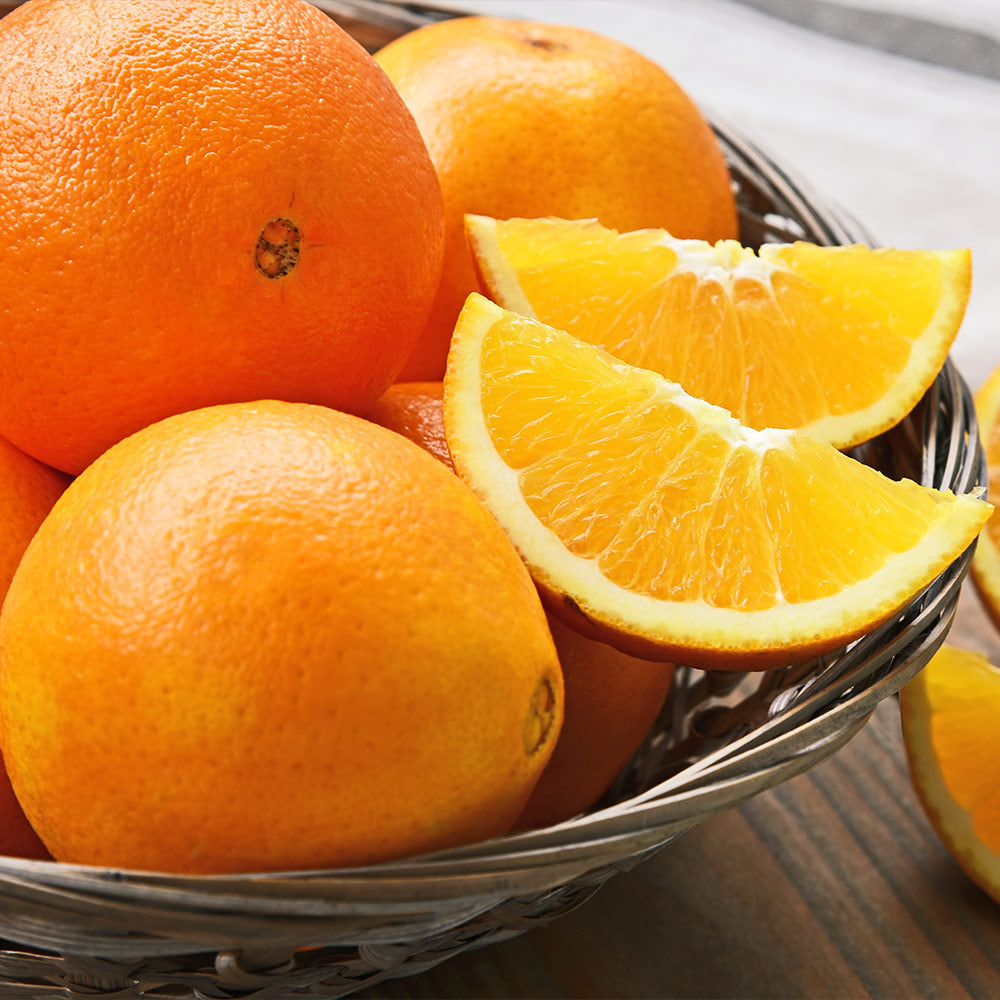* Images shown are of mature plants

Have questions? Talk with our Plant Experts (800) 973-8959
Grow Sweet, Seedless Oranges in Every Climate
You don't need to live in Florida to grow these sweet oranges. Robertson navel oranges can withstand colder and drier climates than most of the popular orange varieties. They are easy to grow inside too. Just keep the tree outside until the first freeze and then place it near a sunny window indoors. As a bonus, you'll get to enjoy the clean, natural fragrance of the winter harvest in your home.
Sweeten your home or garden with fragrant blossoms. Whether you keep your tree indoors or outside, you'll be tempted by the incredible fragrance of the flowers. Sweet and subtle aroma comes from the large, white flowers; the Robertson navel blooms add a full sensory experience.
They're so easy to grow. There's absolutely nothing to caring for a Robertson Orange Tree. This variety can tolerate more cold and drought than other varieties, which means they don't require a lot of watering or pruning. If you've never grown a fruit tree before, you'll be impressed with how easy it is to grow these oranges.
The Robertson navel is a beautiful and manageable tree. Growing to only 8-12 ft., this tree is smaller than many orange tree varieties. The manageable size makes it a great choice for smaller yards. With big, dark green leaves and gorgeous white blossoms, it brings cheerfulness to every environment.
Never run out of oranges. Many mature trees produce nearly 100 oranges every year. Since Robertson navel oranges stay ripe on the branch for a while, you can pick them off when you're ready to enjoy them. They stay fresh in the refrigerator for months and even remain fresh in the freezer for longer, so you'll always have a healthy and sweet snack whenever you want it.
You won't run out of uses for your oranges either. With such a big harvest, you may be wondering what you'll do with all those oranges. From garnishes, sauces, jams and even natural cleaning products, there are plenty of uses for the Robertson navel Orange. That is, of course, If you have any left after making your friends and family really happy with sweet, home-grown gifts.
It's the perfect snack that you don't have to feel bad about. Packed full of vitamins and nutrients, Robertson navel Oranges are really nutritious and don't come with the burden of calories like other sweet snacks. A fresh squeezed juice in the morning is a healthy way to start your day. You can enjoy as many oranges as you want and actually feel good about it.
Start growing your Robertson navel Oranges today. Enticing fragrance and sweet, nutritious fruit easily grown from a gorgeous tree - you'll love everything the Robertson navel Orange tree adds to your home or garden. Order yours today!
Pollination Info
Robertson Navel Orange Tree Pollination
Robertson Navel Orange Trees are self-fertile. You will get fruit with only one plant. However, adding an additional Robertson Navel Orange Tree will drastically increase the size of your crop.
Planting & Care
The Navel Orange (Citrus sinesis 'Osbeck') is a low maintenance, easy to grow, healthy fruit producing tree. The Navel is one of the most sought after oranges not only from their health benefits but also their lovely, aromatic fragrance while in bloom. This full sun loving, semi-dwarf citrus tree is commonly planted in USDA growing zones 8-11 for outdoor planting but successfully container grown in colder zones. The Navel will mature to a height and width of 8-12 feet making them easy to care for and harvesting. The oranges themselves have a longer shelf life than other citrus fruits so no worries about rapid consumption, you can store them!
Seasonal Information: Navel Oranges trees will do best in warmer climates as it is classified as a tropical plant. Zones 8 to 11 are ideal for outdoor planting. However, if you do experience cold winters, plant your Navel Oranges tree in a container and bring it inside for the fall and winter seasons. We recommend planting in Spring through Fall for outdoors since they are sensitive to colder temperatures.
Selecting a location: Choose a location where your tree is going to get plenty of sunlight, 6-8 hours per day is best. They can tolerate some shade, but thrive in full sun. You'll want to ensure trees are spaced 8-10 feet apart if planting more than one. These trees also do better in areas with high humidity so you may also need to create humidity for your tree by misting the leaves daily with water. Potted plants do enjoy a daily misting for humidity but placing a tray with rocks filled with water under the plant will feed humidity to the tree as the water evaporates.
Planting Directions (in Ground): If you are located in zones 8-11 and your winter temperatures stay consistently warm, your Navel Oranges will do well being planting outside in the ground. Be sure the area has well draining soil.
1) Dig a hole twice as wide and just as deep as the root system.
2) Place the tree in the hole and back fill it with your sandy, well-draining, acidic soil. If you have clay soil, try amending it with sand, stone, perlite or fine potting soil.
3) Tamp the soil down as you back fill the hole to cut back on any pockets from forming.
4) After planting, be sure to give your Navel Oranges tree a deep watering for about 5 minutes. Mulching around the tree will help insulate the roots and keep your plant warm in the colder winter months as well.
Planting Instructions (potted): If your winter temperatures are consistently below 40 degrees, plant your tree in a container that can easily be brought outside in the summer months and inside in the winter. A planter with built-in casters is a good choice so it can easily be moved. Choose a pot slightly larger than what it was shipped in that has plenty of holes in the bottom to allow for drainage. Be sure to plant in well-draining potting soil preferably recommended for acid loving citrus plants.
1) Fill your pot halfway with soil. Remove the tree from it's original pot and gently place it in the potting soil.
2) Fill in around the tree with the remainder of the potting soil but be sure not to cover the grafted area of the tree. Leave about an inch from the soil surface to the rim of the pot for easy watering.
3) Lightly pack down the soil. Immediately after planting, give your tree a deep watering until it flows from the holes in the bottom of the pot.
4) Place your tree in an area of your home, preferably a south-facing window, where it is going to get plenty of sunlight. Supplement with a grow light if it will not receive at least 6-8 hours of sunlight a day. You may also need to create humidity for your tree by placing the pot on a saucer of pebbles or misting the leaves daily with water.
Watering: Navel Oranges do not like wet feet. Be sure to give your tree a deep watering so that it can penetrate into the root system. After watering, allow the top 2-3 inches of the soil to dry out completely before watering again. Yellowing and droopy leaves is a common sign of overwatering while brown, dry leaves are a sign of under watering. Mulching can help retain the soil moisture and also combat competing grasses/weeds.
For potted Navel Oranges, stick your index finger into the soil down to about 2 inches. If there is moisture present, hold off on watering until it feels more dry at that depth. When ready to water, stop once you see it escaping the drainage holes at the base of the pot.
Fertilization: Feed your Navel Oranges tree during the warmer spring and summer seasons with a citrus specific fertilizer once every six weeks. Espoma Citrus Tone is highly recommended but any organic fertilizer specifically for citrus should suffice. This will help keep your tree on a healthy growth cycle but also replenish the nutrients in the soil. During the fall and winter season, ease back to fertilizing once every 2-3 months. Once the tree has matured a bit and has got a few years on it, you can skip the cold season fertilization. The same fertilizing regimen should be followed for potted Navel Oranges trees as well. Make sure to follow the application instructions written on the fertilizer bag.
Pruning: Pruning can be done at any time of the year for in ground planted Navel Oranges except in the winter. Make 45-degree angle cuts to remove dead or crossing limbs and also to thin out the tree to allow more light to flow between the branches. “Leggy” looking branches may indicate that there is not enough light getting to the tree’s interior. After the tree fruits, remove any dead wood and ventilate the center of the tree. Remove suckers as they form/grow from the base as they will steal away nutrients from the primary trunk of the tree. Pruning can be done at any time of the year for the potted Navel Oranges.
Shipping Details
Estimated Shipping Time: Most orders ship immediately. As noted on the website, some items are seasonal, and may only ship in spring or fall. Once your order is shipped, you'll receive an email with a tracking number.
| Amount of Order | Shipping Charge |
|---|---|
| Less than $49 | $19.95 |
| $49 + | FREE SHIPPING! |
Product Details
| Mature Height: | 8 ft. |
| Mature Width: | 6-10 ft. |
| Sunlight: | Full-Partial |
| Growth Rate: | Moderate Growing |
| Harvest Time: | Fall |
| Botanical Name: | Citrus sinensis 'Robertson' |
| Does Not Ship To: | AK, AL, AZ, FL, GA, HI, LA, OR, TX |
| Grows Well In Zones: | 3-11 patio / 9-11 outdoors |
| Your Growing Zone: | # |











